Greening agriculture, water scarcity and climate action
Leading the way: Gulf countries' efforts in mangrove restoration
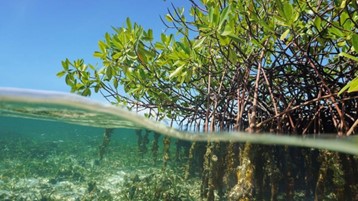
©Oman observer

On the International Day for the Conservation of the Mangrove Ecosystem, we delve into the vital importance of mangroves. These unique coastal ecosystems provide critical habitats for a myriad of marine and terrestrial wildlife. They play a vital role in coastal protection, with their intricate root systems acting as natural barriers that reduce the impact of waves, storm surges, and coastal erosion.
Not only are they biodiversity hotspots, but mangroves are also significant in carbon sequestration, storing substantial amounts of carbon and thereby contributing to climate change mitigation. Globally, mangroves sequester carbon at rates higher than many terrestrial forests, storing approximately 11 billion tonnes of carbon dioxide.
They also improve water quality by filtering pollutants and trapping sediments, which enhances the health of coastal waters. Mangroves support the livelihoods of many coastal communities, providing resources such as timber and medicinal plants and sustaining fisheries.
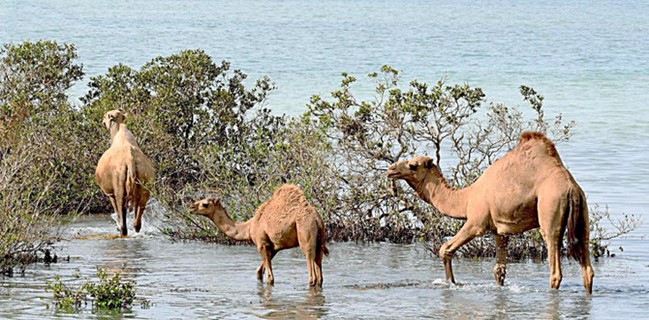
Mangroves provide pastures for camels on islands in the Red Sea that give high-quality nutrition to camels in coastal locations during the winter.
© arabnews.com
Challenges facing mangroves in the Middle East
In the Middle East, mangroves are found along the coasts of countries such as Bahrain, Oman, the Kingdom of Saudi Arabia, and the United Arab Emirates (UAE). These ecosystems face numerous challenges. In the UAE, coastal salinity has increased due to intense desalination activities, creating a hypersaline environment that stunts mangrove growth. Increased seawater temperatures from energy production and desalination practices, pollution from cement factories, rapid development of small islands, and construction of bridges have further stressed the mangrove ecosystems.
FAO's "The World’s Mangroves 2000–2020" report integrates remote sensing with local expertise to assess global mangrove areas and changes over two decades. The study estimated the total mangrove area in 2020 at 14.8 million ha, with nearly 44 percent in South and Southeast Asia. Despite a net decline of 284 000 ha over the 20-year period, the report shows that the annual rate of mangrove loss slowed from 0.12 percent in 2000–2010 to 0.07% in 2010–2020, highlighting the impact of conservation efforts.
Recent assessments by the International Union for Conservation of Nature (IUCN) highlight that the state of Arabian mangroves is now considered vulnerable due to climate change. Rising sea levels, more frequent cyclones, and altered freshwater flows are threatening these ecosystems, which are crucial for biodiversity conservation and coastal resilience. For instance, Oman’s mangroves, covering approximately 1 000 ha, have been impacted by human activities such as fuelwood harvesting and grazing of livestock, compounding the challenges posed by climate change.
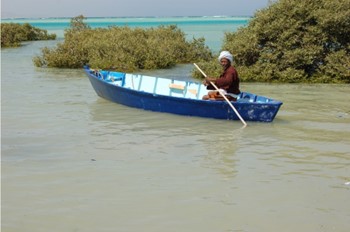
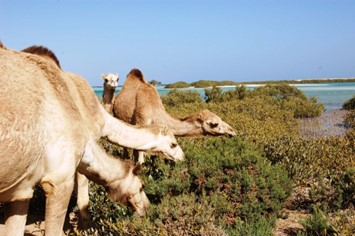
Mangrove of the Red Sea, Sep 15, 2020 ©: Ahmed Fouad
Oman's mangrove restoration
In Oman, the Oman Blue Carbon project represents a groundbreaking initiative by the Environment Authority and MSA Green Projects Company. This ambitious initiative aims to plant 100 million mangrove trees across the Sultanate, significantly enhancing the natural environment. This could reduce carbon dioxide emissions by 14 million tonnes and generate an estimated economic benefit of around $150 million in blue carbon credit certificates in favour of the Environment Authority. FAO plans to initiate a comprehensive mangrove restoration programme in Oman to safeguard and enhance mangrove ecosystems along its coastline. This joint effort can address the various threats facing Oman’s mangroves. Moreover, the collaboration will leverage mangroves’ significant potential for carbon sequestration, aligning with Oman’s national strategy to achieve net-zero carbon emissions by 2050.
This collaboration will aim to strengthen the implementation of the UN Decade on Ecosystem Restoration in Oman, empower the fishers' communities and their accountability in restoring the mangrove for the benefit of their fishing practices, and leverage advanced monitoring techniques and innovative approaches like the FAO’s SEPAL platform to enhance the restoration monitoring techniques.
Mangrove restoration initiatives in Saudi Arabia
Saudi Arabia is undertaking an ambitious initiative to restore its mangrove ecosystems. Mangroves in Saudi Arabia provide essential benefits, including acting as natural filters for pollutants, absorbing heavy metals, and offering habitats for 125 species of fish, crustaceans, and migratory birds. Mangrove swamps also offer valuable grazing areas for camels on Red Sea islands and provide nutritious forage for coastal camels during winter months. Mangroves absorb 70-90 percent of wave energy, protecting coastal communities from erosion and storm damage. These initiatives not only enhance environmental sustainability but also contribute to the Kingdom's broader goals of tackling climate change, reducing carbon emissions, and improving the quality of life for its residents.
Mangroves in the Kingdom, mainly found in fragmented stands along the Red Sea and Arabian Gulf coasts, play a vital role in carbon sequestration and storm protection. In line with the Saudi Green Initiative launched in 2021, the Kingdom of Saudi Arabia aims to plant 10 billion mangrove trees by 2030, significantly boosting the current coverage of approximately 35 500 ha along the Red Sea. Noteworthy projects include the Red Sea Global initiative, which seeks to plant 50 million mangroves by 2030.
Under the Vision 2030 initiative, the Ministry of Environment, Water, and Agriculture has implemented significant projects to enhance mangrove populations. For instance, they transplanted 250 000 mangrove seedlings in Yanbu and planted 1.7 million seedlings along the coasts to increase vegetative cover and support sustainable fisheries. Successful rehabilitation efforts have expanded mangrove areas, with projects in Yanbu notably increasing coverage from 0.011 km² in 1972 to 0.562 km² in 2013. Saudi Aramco has also contributed by planting 2 million mangrove trees along the eastern coast over an area of 60 km² and established the first mangrove park in Tarout Bay in 2020. They have also implemented monitoring initiatives on Tarout Island to protect mangroves from vandalism and pollution. These efforts underscore Saudi Arabia's commitment to preserving mangrove ecosystems and promoting sustainable development in coastal regions.
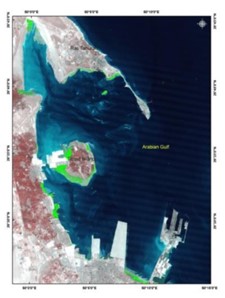 |  | 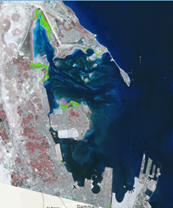 |
Mangrove vegetation in the year 1985, (Picture from King Abdul-Aziz City for Science and Technology, NDVI was generated by the Researcher). | Mangrove vegetation in the year 2011, (Picture from King Abdul-Aziz City for Science and Technology, NDVI was generated by the Researcher). | Mangrove vegetation in the year 2023, (Picture from USGS, NDVI was generated by the Researcher). |
Bahrain’s restoration plans
Bahrain's ambitious mangrove restoration efforts are part of a comprehensive strategy to plant 3.6 million trees by 2035, aligning closely with the goals set forth by the United Nations Framework Convention on Climate Change (UNFCCC). This commitment underscores Bahrain's proactive approach to climate mitigation and adaptation, leveraging natural solutions such as mangrove ecosystems to enhance resilience against climate impacts. The partnership between UN-Habitat and HSBC to restore mangroves in Tubli Bay, including Ras Sanad, not only aims to expand mangrove habitats but also seeks to integrate nature-based solutions into urban planning, fostering community well-being and biodiversity conservation while advancing global climate objectives.
Mangrove restoration in Egypt
In Egypt, a two-year government project was launched in April 2020 aimed at rehabilitating mangrove plantations, with the goal of restoring a total area of 210 ha of mangrove forests along the Red Sea and Sinai coasts failed to take off in some sites but was extremely successful in others. International partnerships, including collaborations with FAO and the International Tropical Timber Organization (ITTO), provide crucial funding and technical assistance. The Mangrove Ecosystem Restoration in Egypt (MERS) project, called “Developing a Participatory Mangrove Ecosystem Restoration Model as a Nature-Based Solution to Climate Change” launched in 2021 as a collaboration between HSBC and the American University in Cairo's Center for Applied Research on the Environment and Sustainability (CARES), aims to restore and expand mangrove ecosystems along Egypt's Red Sea coast. Over five years, MERS plans to plant 10 000 new mangrove seedlings annually in degraded sites from ElGouna to Halayeb and Shalateen, enhancing coastal resilience and biodiversity. This initiative integrates local communities into restoration efforts, promoting economic opportunities such as ecotourism and sustainable business models.
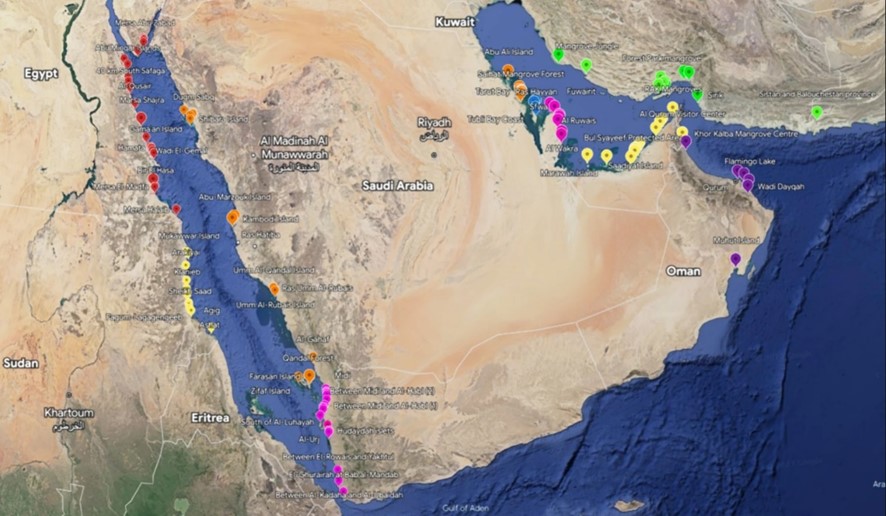
Mangroves distribution in the Middle East and Egypt © springer.com
Commitment to the UN Decade on Ecosystem Restoration
As we navigate the UN Decade on Ecosystem Restoration (2021-2030), mangroves emerge as emblematic of nature-based solutions to global challenges. Restoring mangrove habitats aligns with the Decade’s goals of halting biodiversity loss, combating desertification, and addressing climate change impacts. Gulf countries are at the forefront of these efforts, demonstrating a strong commitment to protecting and restoring mangrove habitats. By integrating traditional knowledge and leveraging advanced technologies, these countries are setting an example for the world.
In the United Arab Emirates, specifically in Abu Dhabi, a landmark marine restoration initiative is underway to restore seagrass beds, coral reefs, and mangroves along the Gulf coast. This UN Decade flagship underscores a commitment to conserving and restoring coastal habitats, including mangroves. By focusing on the restoration of seagrass beds, coral reefs, and mangrove forests along the Gulf coast, Abu Dhabi also aims to enhance biodiversity and protect marine species such as the dugong—a vegetarian marine mammal reliant on seagrass meadows and mangrove habitats.
Learn more about mangroves
- Unlocking the secrets of mangroves: Unlocking the secrets of mangroves (fao.org)
- FAO Forestry Division’s work on mangroves: https://www.fao.org/forestry/mangrove/en
- FAO’s Sustainable Forest Management (SFM) Toolbox module on mangroves: https://www.fao.org/sustainable-forest-management/toolbox/modules/mangroves-restoration-and-management/tools/en/
- Red list of Mangrove ecosystems: https://www.iucn.org/resources/conservation-tool/iucn-red-list-ecosystems/red-list-mangrove-ecosystems
- The State of the World's Mangroves: https://www.mangrovealliance.org/mangrove-forests/
- Oman's Blue Carbon project: https://www.omanobserver.om/article/1144305/oman/environment/omans-blue-carbon-project-to-cut-14-million-tonnes-co2-emissions
- The World’s Mangroves 2000-2020: content (fao.org)
